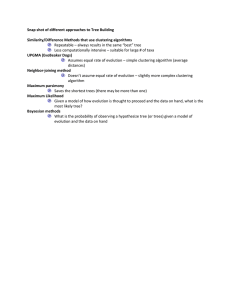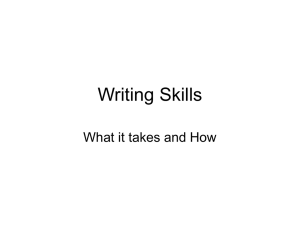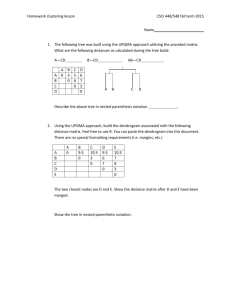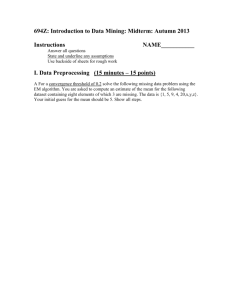Using Representative-Based Clustering for Nearest Neighbor
advertisement
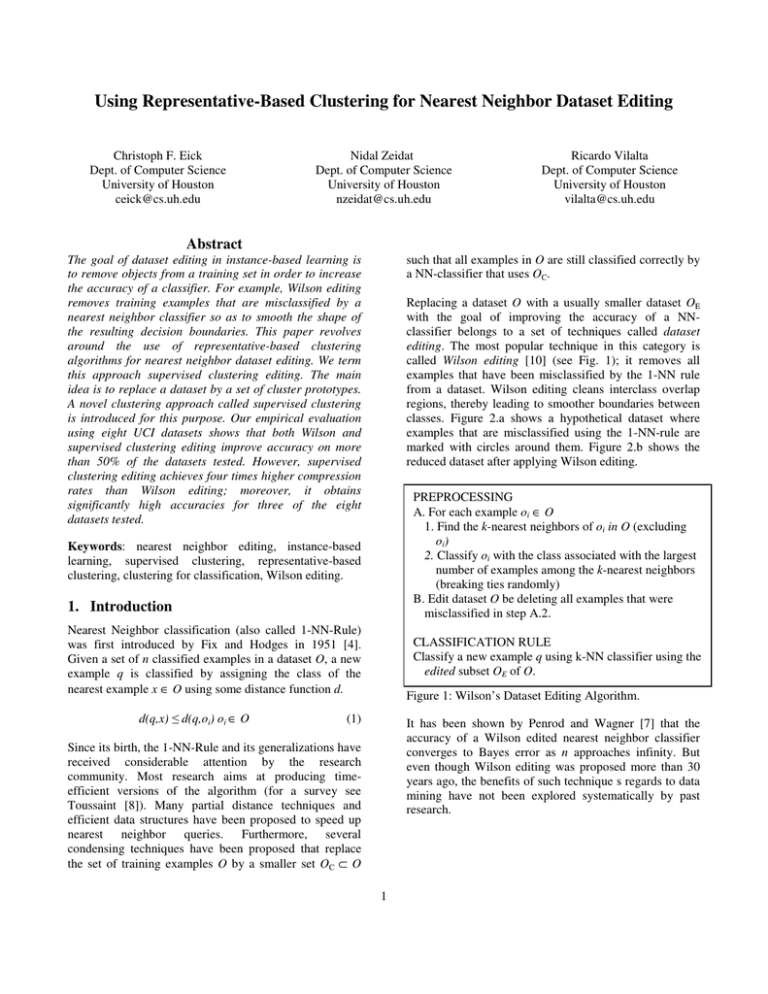
Using Representative-Based Clustering for Nearest Neighbor Dataset Editing
Christoph F. Eick
Dept. of Computer Science
University of Houston
ceick@cs.uh.edu
Nidal Zeidat
Dept. of Computer Science
University of Houston
nzeidat@cs.uh.edu
Abstract
such that all examples in O are still classified correctly by
a NN-classifier that uses OC.
The goal of dataset editing in instance-based learning is
to remove objects from a training set in order to increase
the accuracy of a classifier. For example, Wilson editing
removes training examples that are misclassified by a
nearest neighbor classifier so as to smooth the shape of
the resulting decision boundaries. This paper revolves
around the use of representative-based clustering
algorithms for nearest neighbor dataset editing. We term
this approach supervised clustering editing. The main
idea is to replace a dataset by a set of cluster prototypes.
A novel clustering approach called supervised clustering
is introduced for this purpose. Our empirical evaluation
using eight UCI datasets shows that both Wilson and
supervised clustering editing improve accuracy on more
than 50% of the datasets tested. However, supervised
clustering editing achieves four times higher compression
rates than Wilson editing; moreover, it obtains
significantly high accuracies for three of the eight
datasets tested.
Replacing a dataset O with a usually smaller dataset OE
with the goal of improving the accuracy of a NNclassifier belongs to a set of techniques called dataset
editing. The most popular technique in this category is
called Wilson editing [10] (see Fig. 1); it removes all
examples that have been misclassified by the 1-NN rule
from a dataset. Wilson editing cleans interclass overlap
regions, thereby leading to smoother boundaries between
classes. Figure 2.a shows a hypothetical dataset where
examples that are misclassified using the 1-NN-rule are
marked with circles around them. Figure 2.b shows the
reduced dataset after applying Wilson editing.
PREPROCESSING
A. For each example oi ∈ O
1. Find the k-nearest neighbors of oi in O (excluding
oi)
2. Classify oi with the class associated with the largest
number of examples among the k-nearest neighbors
(breaking ties randomly)
B. Edit dataset O be deleting all examples that were
misclassified in step A.2.
Keywords: nearest neighbor editing, instance-based
learning, supervised clustering, representative-based
clustering, clustering for classification, Wilson editing.
1. Introduction
Nearest Neighbor classification (also called 1-NN-Rule)
was first introduced by Fix and Hodges in 1951 [4].
Given a set of n classified examples in a dataset O, a new
example q is classified by assigning the class of the
nearest example x ∈ O using some distance function d.
d(q,x)
d(q,oi) oi ∈ O
Ricardo Vilalta
Dept. of Computer Science
University of Houston
vilalta@cs.uh.edu
CLASSIFICATION RULE
Classify a new example q using k-NN classifier using the
edited subset OE of O.
Figure 1: Wilson’s Dataset Editing Algorithm.
(1)
It has been shown by Penrod and Wagner [7] that the
accuracy of a Wilson edited nearest neighbor classifier
converges to Bayes error as n approaches infinity. But
even though Wilson editing was proposed more than 30
years ago, the benefits of such technique s regards to data
mining have not been explored systematically by past
research.
Since its birth, the 1-NN-Rule and its generalizations have
received considerable attention by the research
community. Most research aims at producing timeefficient versions of the algorithm (for a survey see
Toussaint [8]). Many partial distance techniques and
efficient data structures have been proposed to speed up
nearest neighbor queries. Furthermore, several
condensing techniques have been proposed that replace
the set of training examples O by a smaller set OC ⊂ O
1
Section 4 summarizes the results of this paper and
identifies areas of future research.
Attribute1
Attribute1
A summary of the notations used throughout the paper is
given in Table 1.
Attribute2
a. Hypothetical Dataset
Notation
O={o1, …, on}
n
d(oi,oj)
c
Ci
Description
Objects in a dataset (training set)
Number of objects in the dataset
Distance between objects oi & oj
The number of classes in the dataset
Cluster associated with the i-th
representative
X={C1, …, Ck} A clustering solution consisting of
clusters C1 to Ck
k=|X|
The number of clusters (or
representatives) in a clustering
solution X
q(X)
A fitness function that evaluates a
clustering X, see formula (2)
Table 1: Notations Used in the Paper.
Attribute2
b. Dataset Edited using
Wilson’s Technique
Figure 2: Wilson Editing for a 1-NN Classifier.
Devijver and Kittler [2] proposed an editing technique
they call multi-edit that repeatedly applies Wilson editing
to random partitions of the data set until a predefined
termination condition is met. Moreover, several variations
of Wilson editing have been proposed for k-nearest
neighbor classifiers (e.g. in Hattori and Takahashi [5]).
Finally, the relationship between condensing and editing
techniques has been systematically analyzed in the
literature (see for example Dasaranthy, Sanchez, and
Townsend [1]).
2. Using Supervised Clustering for Dataset
Editing
Due to its novelty, the goals and objectives of supervised
clustering will be discussed in the first subsection. The
second subsection introduces representative-based
supervised clustering algorithms. Finally, we will explain
how supervised clustering can be used for nearest
neighbor dataset editing.
In addition to analyzing the benefits of Wilson editing,
this paper proposes a new approach based on using
representative-based clustering algorithms for nearest
neighbor editing. The idea is to replace a dataset by a set
of cluster prototypes. A new data set editing technique is
proposed that applies a supervised clustering algorithm
[11] to the dataset, and uses the resulting cluster
representatives as the output of the editing process. We
will refer to this editing technique as supervised
clustering editing (SCE); we will refer to the
corresponding nearest neighbor classifier as nearest
representative (NR) classifier. Unlike traditional
clustering, supervised clustering is applied on classified
examples with the objective of identifying clusters that
maximize the degree of class purity within each cluster.
Supervised clustering seeks to identify regions on the
attribute space that are dominated by instances of a single
class, as depicted in Fig. 3.b.
2.1
Supervised Clustering
Clustering is typically applied in an unsupervised learning
framework using particular error functions, e.g. an error
function that minimizes the distances inside a cluster.
Supervised clustering, on the other hand, deviates from
traditional clustering in that it is applied on classified
examples with the objective of identifying clusters having
not only strong cohesion but also class purity. Moreover,
in supervised clustering, we try to keep the number of
clusters small, and objects are assigned to clusters using a
notion of closeness with respect to a given distance
function.
The remainder of this paper is organized as follows.
Section 2 introduces supervised clustering and explains
how supervised clustering dataset editing works. Section
3 discusses experimental results that compare Wilson
editing, supervised clustering editing, and traditional,
”unedited” nearest-neighbor classifiers, with respect to
classification accuracy and dataset reduction rates.
2
a major challenge for most search algorithms,
especially hill climbing and greedy algorithms.
The fitness functions used for supervised clustering are
quite different from the ones used by traditional
clustering algorithms. Supervised clustering evaluates a
clustering based on the following two criteria:
• Class impurity, Impurity(X). Measured by the
percentage of minority examples in the different
clusters of a clustering X. A minority example is an
example that belongs to a class different from the
most frequent class in its cluster.
• Number of clusters, k. In general, we favor a low
number of clusters; but clusters that only contain a
single example are not desirable, although they
maximize class purity.
Attribute1
q(X) = Impurity(X) + β∗Penalty(k)
Impurity
(X ) =
# of Minority Examples
n
k−c
Penalty
(k ) =
n
0
a. Dataset clustered using
a traditional clustering
algorithm
,
L
Attribut 2
b. Dataset clustered using
a supervised clustering
algorithm.
Fig. 3 illustrates the differences between traditional and
supervised clustering. Let us assume that the black
examples and the white examples in the figure represent
subspecies of Iris plants named Setosa and Virginica,
respectively. A traditional clustering algorithm, such as
the k-medoid algorithm [6], would, very likely, identify
the six clusters depicted in Figure 3.a. Cluster
representatives are encircled. If our objective is to
generate summaries for the Virginica and Setosa classes
of the Iris Plant, for example, the clustering in Figure 3.a
would not be very attractive since it combines Setosa
(black circles) and Virginica objects (white circles) in
cluster A and allocates examples of the Virginica class
(white circles) in two different clusters B and C, although
these two clusters are located next to each other.
k ≥ c
k < c
Two special cases of the above fitness function should be
mentioned; the first case is a clustering X1 that uses only
c clusters; the second case is a clustering X2 that uses n
clusters and assigns a single object to each cluster,
therefore making each cluster pure. We observe that
q(X1)=Impurity(X1) and q(X2)≈β.
A supervised clustering algorithm that maximizes class
purity, on the other hand, would split cluster A into two
clusters G and H. Another characteristic of supervised
clustering is that it tries to keep the number of clusters
low. Consequently, clusters B and C would be merged
into one cluster without compromising class purity while
reducing the number of clusters. A supervised clustering
algorithm would identify cluster I as the union of clusters
B and C as depicted in Figure 3.b.
Finding the best, or even a good, clustering X with respect
to the fitness function q is a challenging task for a
supervised clustering algorithm due to the following
reasons (these matters have been discussed in more detail
in [3,11]):
1. The search space is very large, even for small
datasets.
2. The fitness landscape of q contains a large number of
local minima.
3. There are a significant number of ties1 in the fitness
landscape creating plateau-like structures that present
Clusterings X1 and X2 with q(X1)=q(X2).
K
Figure 3: Traditional and Supervised Clustering.
with n being the total number of examples and c being the
number of classes in a dataset. Parameter β (0<
3.0)
determines the penalty that is associated with the numbers
of clusters, k: higher values for β imply larger penalties as
the number of clusters increases.
1
F
Attribute2
(2)
I
C
E
H
J
D
B
In particular, we use the following fitness function in our
experimental work (lower values for q(X) indicate ‘better’
quality of clustering X).
where
Attribute1
G
A
2.2 Representative-Based Supervised Clustering
Algorithms
Representative-based clustering aims at finding a set of k
representatives that best characterize a dataset. Clusters
are created by assigning each object to the closest
representative. Representative-based supervised clustering
3
algorithms seek to accomplish the following goal: Find a
subset OR of O such that the clustering X obtained by
using the objects in OR as representatives minimizes q(X).
REPEAT r TIMES
curr := randomly generated set of
representatives with size between c+1 and 2*c
WHILE NOT DONE DO
1. Create new solutions S by adding a
single non-representative to curr and
by removing a single representative
from curr
2. Determine the element s in S for
which q(s) is minimal (if there is
more than one minimal element,
randomly pick one)
3. IF q(s)<q(curr) THEN curr:=s
ELSE IF q(s)=q(curr) AND |s|>|curr|
THEN curr:=s
ELSE terminate and return curr as the
solution for this run.
Report the best out of the r solutions found.
One might ask why our work centers on developing
representative-based supervised clustering algorithms.
The reason is representatives (such as medoids) are quite
useful for data summarization. Moreover, clustering
algorithms that restrict representatives to objects
belonging to the dataset, such as the k-medoid algorithm,
Kaufman [6], explore a smaller solution space if
compared with centroid–based clustering algorithms, such
as the k-means algorithm2. Finally, when using
representative-based clustering algorithms, only an interobject distance matrix is needed and no “new” distances
have to be computed, as it is the case with k-means.
As part our research, we have designed and evaluated
several supervised clustering algorithms [3]. Among the
algorithms investigated, one named Single Representative
Insertion/Deletion Steepest Decent Hill Climbing with
Randomized Restart (SRIDHCR for short) performed
quite well3. This greedy algorithm starts by randomly
selecting a number of examples from the dataset as the
initial set of representatives. Clusters are then created by
assigning examples to their closest representative.
Starting from this randomly generated set of
representatives, the algorithm tries to improve the quality
of the clustering by adding a single non-representative
example to the set of representatives as well as by
removing a single representative from the set of
representatives. The algorithm terminates if the solution
quality (measured by q(X)) does not show any
improvement. Moreover, we assume that the algorithm is
run r (input parameter) times starting from a randomly
generated initial set of representatives each time,
reporting the best of the r solutions as its final result. The
pseudo-code of the version of SRIDHCR that was used
for the evaluation of supervised clustering editing is given
in Figure 4. It should be noted that the number of clusters
k is not fixed for SRIDHCR; the algorithm searches for
“good” values of k.
Figure 4: Pseudo Code of SRIDHCR.
2.3 Using Cluster Prototypes for Dataset Editing
In this paper we propose using supervised clustering as a
tool for editing a dataset O to produce a reduced subset
Or. The subset Or consists of cluster representatives that
have been selected by a supervised clustering algorithm.
A 1-NN classifier, that we call nearest-representative
(NR) classifier, is then used for classifying new examples
using subset Or instead of the original dataset O. Figure 5
presents the classification algorithm that the NR classifier
employs. A NR classifier can be viewed as a compressed
1-nearest-neighbor classifier because it uses only k (k<n)
examples out of the n examples in the dataset O.
PREPROCESSING
A. Apply a representative-based supervised
clustering algorithm (e.g. SRIDHCR) on dataset
O to produce a set of k prototypical examples.
B. Edit dataset O by deleting all non-representative
examples to produce subset Or.
CLASSIFICATION RULE
Classify a new example q by using a 1-NN classifier
with the edited subset Or.
Figure 5: Nearest Representative (NR) Classifier.
2
3
There are 2n possible centroids for a dataset containing n
objects.
Another algorithm named SCEC [12] that employs
evolutionary computing to evolve a population consisting of
sets of representatives, also denoted good performance.
Figure 6 gives an example that illustrates how supervised
clustering is used for dataset editing. Figure 6.a shows a
dataset that was partitioned into 6 clusters using a
supervised clustering algorithm. Cluster representatives
4
are marked with circles around them. Figure 6.b shows
the result of supervised clustering editing.
Attribute1
A
In general, an editing technique reduces the size n of a
dataset to a smaller size k. We define the dataset
compression rate of an editing technique as:
k
Compression Rate = 1 −
(3)
n
Attribute1
B
E
In order to explore different compression rates for
supervised clustering editing, three different values for
parameter β were used in the experiments: 1.0, 0.4, and
0.1.
D
C
G
F
Attribute 2
a. Dataset clustered using
supervised clustering.
Prediction accuracies were measured using 10-fold crossvalidation throughout the experiments for the four
classifiers tested. Representatives for the nearest
representative (NR) classifier were computed using a
version of the SRIDHCR supervised clustering algorithm
that was introduced in Section 2.2. In our experiments,
SRIDHCR was restarted 50 times (r = 50), each time with
a different initial set of representatives, and the best
solution (i.e., set of representatives) found in the 50 runs
was used as the edited dataset for the NR classifier.
Accuracies and compression rates were obtained for a 1NN-classifier that operates on subsets of the 8 datasets
obtained using Wilson editing. We also computed
prediction accuracy for a traditional 1-NN classifier that
uses all training examples when classifying a new
example. The reported accuracies of the traditional 1-NNclassifier serve as a baseline for evaluating the benefits of
the two editing techniques. Finally, we also report
prediction accuracy for decision-tree learning algorithm
C4.5 that was run using its default parameter settings.
Table 3 reports the accuracies obtained by the four
classifiers evaluated in our experiments.
Attribute2
b. Dataset edited using
cluster representatives.
Figure 6: Editing a Dataset Using Supervised Clustering.
3. Experimental Results
To evaluate the benefits of Wilson editing and supervised
clustering editing (SCE), we applied these techniques to a
benchmark consisting of 8 datasets that were obtained
from the UCI Machine Learning Repository [9]. Table 2
gives a summary of these datasets.
All datasets were normalized using a linear interpolation
function that assigns 1 to the maximum value and 0 to the
minimum value. Manhattan distance was used to compute
the distance between two objects.
Dataset name
# of
objects
214
270
294
# of
attributes
9
13
13
Glass
Heart-Statlog
Heart-DiseaseHungarian (Heart-H)
Iris Plants
150
4
Pima Indians Diabetes
768
8
Image Segmentation
2100
19
Vehicle Silhouettes
846
18
Waveform
5000
21
Table 2: Datasets Used in the Experiments.
# of
classes
6
2
2
Table 4 reports the average dataset compression rates for
supervised clustering editing and Wilson editing. Due to
the fact that the supervised clustering algorithm has to be
run 10 times, once for each fold, different numbers of
representatives are usually obtained for each fold.
Consequently, Table 4, also, reports the average,
minimum, and maximum number of representatives found
on the 10 runs. For example, when running the NR
classifier for the Diabetes dataset with β set to 0.1 the
(rounded) average number of representatives was 27, the
maximum number of representatives during the 10 runs
was 33 and the minimum number of representatives was
22; supervised clustering editing reduced the size of the
original dataset O by an average of 96.5%, as displayed in
Table 4. The NR classifier classified 73.6% of the testing
examples correctly, as indicated in Table 3. Table 4 only
reports average compression rates for Wilson editing.
Minimum and maximum compression rates observed in
different folds are not reported, because the deviations
among these numbers were quite small.
3
2
7
4
3
Parameter β has a strong influence on the number k of
representatives chosen by the supervised clustering
algorithm; i.e., the size of the edited dataset Or. If high
β values are used, clusterings with a small number of
representatives are likely to be chosen. On the other hand,
low values for β are likely to produce clusterings with a
large number of representatives.
5
NR
Glass (214)
0.1
0.636
0.4
0.589
1.0
0.575
Heart-Stat Log (270)
0.1
0.796
0.4
0.833
1.0
0.838
Diabetes (768)
0.1
0.736
0.4
0.736
1.0
0.745
Vehicle (846)
Wilson
1-NN
C4.5
0.607
0.607
0.607
0.692
0.692
0.692
0.677
0.677
0.677
0.804
0.804
0.804
0.767
0.767
0.767
0.782
0.782
0.782
0.734
0.734
0.734
0.690
0.690
0.690
0.745
0.745
0.745
Avg. k
SCE
Wilson
[Min-Max]
Compression
Compression
for SCE
Rate
Rate
Glass (214)
0.1
34 [28-39]
84.3
27
0.4
25 [19-29]
88.4
27
1.0
6 [6 – 6]
97.2
27
Heart-Stat Log (270)
0.1
15 [12-18]
94.4
22.4
0.4
2 [2 – 2]
99.3
22.4
1.0
2 [2 – 2]
99.3
22.4
Diabetes (768)
0.1
27 [22-33]
96.5
30.0
0.4
9 [2-18]
98.8
30.0
1.0
2 [2 – 2]
99.74
30.0
Vehicle (846)
0.1
57 [51-65]
97.3
30.5
0.4 38 [ 26-61]
95.5
30.5
1.0
14 [ 9-22]
98.3
30.5
Heart-H (294)
0.1
14 [11-18]
95.2
21.9
0.4
2
99.3
21.9
1.0
2
99.3
21.9
Waveform (5000)
0.1 104 [79-117]
97.9
23.4
0.4
28 [20-39]
99.4
23.4
1.0
4 [3-6]
99.9
23.4
Iris-Plants (150)
0.1
4 [3-8]
97.3
6.0
0.4
3 [3 – 3]
98.0
6.0
1.0
3 [3 – 3]
98.0
6.0
Segmentation (2100)
0.1
57 [48-65]
97.3
2.8
0.4
30 [24-37]
98.6
2.8
1.0
14
99.3
2.8
Table 4: Dataset Compression Rates for SCE and Wilson
Editing .
0.1
0.667
0.716
0.700 0.723
0.4
0.667
0.716
0.700 0.723
1.0
0.665
0.716
0.700 0.723
Heart-H (294)
0.1
0.755
0.809
78.33 80.22
0.4
0.793
0.809
78.33 80.22
1.0
0.809
0.809
78.33 80.22
Waveform (5000)
0.1
0.834
0.796
0.768 0.781
0.4
0.841
0.796
0.768 0.781
1.0
0.837
0.796
0.768 0.781
Iris-Plants (150)
0.1
0.947
0.936
0.947 0.947
0.4
0.973
0.936
0.947 0.947
1.0
0.953
0.936
0.947 0.947
Segmentation (2100)
0.1
93.81
0.966
0.956 0.968
0.4
91.9
0.966
0.956 0.968
1.0
88.95
0.966
0.956 0.968
Table 3: Predition Accuracy for the four Algorithms.
If we inspect the results displayed in Table 3, we can see
that Wilson editing is a quite useful technique for
improving traditional 1-NN-classfiers. Using Wilson
editing leads to higher accuracies for 6 of the 8 datasets
tested (e.g., Heart-StatLog, Diabetes, Vehicle, Heart-H,
Waveform, and Segmentation) and only shows a
significant loss in accuracy for the Glass dataset. The SCE
approach, on the other hand, accomplished significant
improvement in accuracy for the Heart-Stat Log,
Waveform, and Iris-Plants datasets, outperforming
Wilson editing by at least 2% in accuracy for those
datasets. It should also be mentioned that the achieved
accuracies are significantly higher than those obtained by
C4.5 for those datasets. However, our results also indicate
that SCE does not work well for all datasets. A significant
loss in accuracy can be observed for the Glass and
Segmentation datasets.
More importantly, looking at Table 4, we notice that with
the exception of the Glass and the Segmentation datasets,
SCE accomplishes compression rates of more than 95%
without a significant loss in prediction accuracy for the
other 6 datasets. For example, for the Waveform dataset, a
1-NN classifier that only uses 28 representatives
outperforms the traditional 1-NN classifier that uses all
4500 training examples4 by 7.3% points in accuracy,
increasing the accuracy from 76.8% to 84.1%. Similarly,
for the Heart-StatLog dataset, a 1-NN classifier that uses
just one representative for each class outperforms C4.5 by
4
6
Due to the fact that we use 10-fold cross-validation training
sets contain 0.9*5000=4500 examples.
more than 5% points, and the traditional 1-NN classifier
by more than 6% points.
algorithm keeping the number of clusters, k, fixed.
Parameter β narrows the search space to values of k
corresponding to “good” solutions, but does not restrict it
to a single value. Consequently, a supervised clustering
algorithm still tries to find the best value of k within the
boundaries induced by without the need for any prior
knowledge of what values for k are “good” on a particular
dataset.
As mentioned earlier, Wilson editing reduces the size of a
dataset by removing examples that have been
misclassified by a k-NN classifier. Consequently, the data
set reduction rates are quite low on “easy” classification
tasks for which high prediction accuracies are normally
achieved. For example, Wilson editing produces dataset
reduction rates of only 2.8% and 6.0% for the
Segmentation and Iris datasets, respectively. Most
condensing approaches, on the other hand, reduce the size
of a dataset by removing examples that have been
classified correctly by a nearest neighbor classifier.
Finally, supervised clustering editing reduces the size of a
dataset by removing examples that have been classified
correctly as well as examples that have not been classified
correctly. A representative-based supervised clustering
algorithm is used that aims at finding clusters that are
dominated by instances of a single class, and tends to pick
as the cluster representative5 objects that are in the center
of the region associated with the cluster. As depicted in
Fig. 6, supervised clustering editing just keeps the cluster
representative and removes all other objects belonging to
a cluster from the dataset. Furthermore, it seeks to
minimize the fitness function q(X) rather than considering
which objects have been or have not been classified
correctly by a k-nearest neighbor classifier.
4. Conclusion
The goal of dataset editing in instance-based learning is to
remove objects from a training set in order to increase the
accuracy of the learnt classifier. In contrast to condensing
techniques, editing techniques have not received much
attention in the machine learning and data mining
literature. One popular dataset editing technique is Wilson
editing. It removes those examples from a training set that
are misclassified by a nearest neighbor classifier. In this
paper, we evaluate the benefits of Wilson editing using a
benchmark consisting of eight UCI datasets. Our results
show that Wilson editing enhanced the accuracy of a
traditional nearest neighbor classifier on six of the eight
datasets tested. Wilson editing achieved an average
compression rate of about 20%. It is also important to
note that Wilson editing, although initially proposed for
nearest neighbor classification, can easily be used for
other classification tasks. For example, a dataset can
easily be “Wilson edited” by removing all training
examples that have been misclassified by a decision tree
classification algorithm.
It can also be seen that the average compression rate for
Wilson editing is approximately 20%, and that supervised
clustering editing obtained compression rates that are
usually at least four times as high. Prior to conducting the
experiments we expected that the NR classifier would
perform better for lower compression rates. However, as
can be seen in Table 4, this is not the case: for six of the
eight datasets, the highest accuracies were obtained using
β=0.1 or β=0.4, and only for two datasets the highest
accuracy was obtained using β=1.0. For example, for the
Diabetes dataset using just 2 representatives leads to the
highest accuracy of 74.5%, whereas a 1-NN classifier that
uses all 768 objects in the dataset achieves a lower
accuracy of 69%. The accuracy gains obtained using a
very small number of representatives for several datasets
are quite surprising.
In this paper, we introduced a new technique for dataset
editing called supervised clustering editing (SCE). The
idea of this approach is to replace a dataset by a subset of
cluster prototypes. We introduced a novel clustering
approach, called supervised clustering, that determines
clusters and cluster prototypes in the context of dataset
editing. Supervised clustering, itself, aims at identifying
class-uniform clusters that have high probability densities.
Using supervised clustering editing, we implemented a
1NN-classifier, called nearest representative (NR)
classifier. Experiments were conducted that compare the
accuracy and compression rates of the proposed NR
classifier, with a 1-NN classifier that employs Wilson
editing, and with a traditional, unedited, 1-NN classifier.
Results show that the NR-classifier accomplished
significant improvements in prediction accuracy for 3 out
of the 8 datasets used in the experiments, outperforming
the Wilson editing based 1-NN classifier by more than
2%. Moreover, experimental results show that for 6 out
the 8 datasets tested, SCE achieves compression rates of
more than 95% without significant loss in accuracy. We
also explored using very high compression rates and its
We also claim that our approach of associating a generic
penalty function with the number of clusters has clear
advantages when compared to running a clustering
5
Representatives are rarely picked at the boundaries of a region
dominated by a single class, because boundary points have the
tendency to attract points of neighboring regions that are
dominated by other classes, therefore increasing cluster
impurity.
7
effect on accuracy. We observed that high accuracy gains
were achieved using only a very small number of
representatives for several datasets. For example, for the
Waveform dataset, a traditional 1-NN classifier that uses
all 5000 examples accomplished an accuracy of 76.8%.
The NR-classifier, on the other hand, uses only an
average of 28 examples, and achieved an accuracy of
84.1%. In summary, our empirical results stress the
importance of centering more research on dataset editing
techniques.
[12] Zhao, Z., “Evolutionary Computing and Splitting
Algorithms for Supervised Clustering”, Master’s Thesis,
Dept. of Computer Science, University of Houston, May
2004.
Our future work will focus on 1) using data set editing
with other classification techniques, 2) making data set
editing techniques more efficient, and 3) exploring the
relationships between condensing techniques and
supervised clustering editing. We also plan to make our
supervised clustering algorithms readily available on the
web.
References
[1] Dasarathy, B.V., Sanchez, J.S., and Townsend, S., “Nearest
neighbor editing and condensing tools – synergy
exploitation”, Pattern Analysis and Applications, 3:19-30,
2000.
[2] Devijver, P. and Kittler, J., “Pattern Recognition: A
Statistical Approach”, Prentice-Hall, Englewood Cliffs, NJ,
1982.
[3] Eick, C., Zeidat, N., and Zhao, Z., “Supervised Clustering Objectives and Algorithms. submitted for publication.
[4] Fix, E. and Hodges, J., “Discriminatory Analysis.
Nonparametric Discrimination: Consistency Properties”,
Technical Report 4, USAF School of Aviation Medicine,
Randolph Field, Texas, 1951.
[5] Hattori, K. and Takahashi, M., “A new edited k-nearest
neighbor rule in the pattern classification problem”, Pattern
Recognition, 33:521-528, 2000.
[6] Kaufman, L. and Rousseeuw, P. J., “Finding Groups in
Data: an Introduction to Cluster Analysis”, John Wiley &
Sons, 1990.
[7] Penrod, C. and Wagner, T., “Another look at the edited
nearest neighbor rule”, IEEE Trans. Syst., Man, Cyber.,
SMC-7:92–94, 1977.
[8] Toussaint, G., “Proximity Graphs for Nearest Neighbor
Decision Rules: Recent Progress”, Proceedings of the 34th
Symposium on the INTERFACE, Montreal, Canada, April
17-20, 2002.
[9] University of California at Irving, Machine Learning
Repository.
http://www.ics.uci.edu/~mlearn/MLRepository.html
[10] Wilson, D.L., “Asymptotic Properties of Nearest Neighbor
Rules Using Edited Data”, IEEE Transactions on Systems,
Man, and Cybernetics, 2:408-420, 1972.
[11] Zeidat, N., Eick, C., “Using k-medoid Style Algorithms for
Supervised Summary Generation”, Proceedings of
MLMTA, Las Vegas, June 2004.
8
